Art? Part VII: Why is this crap hanging in a museum?
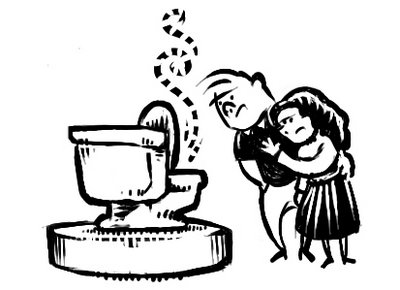
So far we’ve been spending a lot of time looking at Art that’s considered controversial. Now we’ll question its value. If we concede that it is indeed Art because it was made with intent and is an interpretation of the artist’s universe, do we also have to agree that it belongs on the wall of my local art haus?
Nope!
“Really?” you ask. “I actually have some say in whether the so-called Art I’m looking at is crap or not?”
Yup!
“So why is that crap hanging in my museum then?”
More to the point is how the determination is made whether a work of Art is good, who gets to decide, and if that label is permanent.
The Ronco Goodness Scale™
Once a month a group of Metro Detroit artists gather in a smoke filled bar in the hamlet of Hamtramck for a session of figure drawing called Dr. Sketchy. Models are culled from the local burlesque scene and we all pull out our pencils or whatever and do our best to capture the action in front of us. As an artist I am occasionally happy with my results and might proclaim a particular drawing my best from that night. To me it’s a good representation of what I see jiggling in front of me. So I call it good. And John sitting next to me might lean over and say, “Hey, that is good!” So it must be good right? But I might lean back over John’s sketchbook and say, “Maybe mine’s good, but I like yours better! It’s awesome!” Suddenly my drawing’s not so good as it was a moment ago.
If I flip back through my sketchbook and compare my sketch to others I’ve done in the past, it might lose even more standing on the “good” scale. It’s not that good at all now, is it? Then the Swag Faerie bypasses my “work of Art” as well as John’s and picks someone else’s to win a prize bag full of goodies. What the hell just happened? I thought mine was good? Apparently not.
It looks like our idea of what’s good is in comparison to other Art that’s out there for us to see. So, does that mean there is some scale to look at where Art is rated? One where the Mona Lisa sits at the top and where sticks with limes stuck on them are at the bottom? Where does something like Marcel Duchamp’s Fountain fall?
Above or below my work? Near the bottom though for sure, right? But why was his urinal voted the most influential artwork of the 20th century by 500 British Art professionals? Were they all full of it? Do I have to pull my scale out and compare my now apparently shitty Art with all other Art to determine whether it should just be tossed into the trash? Does that scale even matter?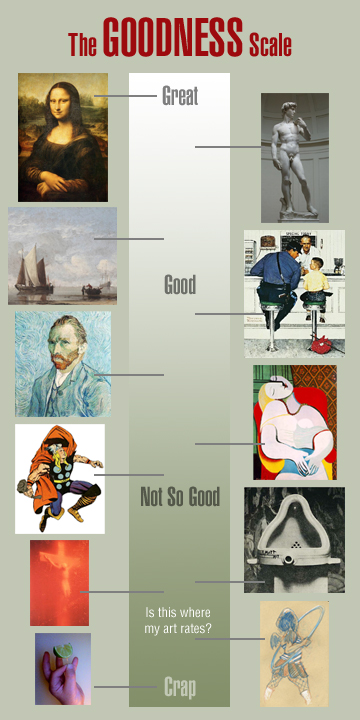
Heck no.
It all depends on what situation in which we’re looking at the Art and by what criteria we judge its goodness. As music goes the Mona Lisa is crap.
“Wait,...what? Why would we even think to place the constraints of what makes good music upon a painting?!”
“Why?” indeed. I don't expect the Mona Lisa to offer me anything in the way of musical entertainment. Likewise, why would I compare my sketch of a hula-hooping zombie cheerleader to the Mona Lisa when all I want to know is how good it is in comparison to other work I’ve done?
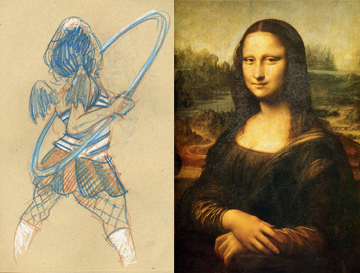
A work of Art can only be rated good or bad by what we expect out of it. It’s highly subjective. Remember that the next time your young niece asks you if you think the picture she made for you is good.
So we ask, when confronted with Art we don’t like, “Why does anyone consider things like this to be good?” Well, why do people like Impressionist paintings? Back in the latter half of the 19th century Impressionism was thought of as a plague on the Art world. How dare these...these...Bohemians try to pass this crap off as Art? It all has to do with the intent of the artist again.
The intention of Impressionist paintings was not to strive to be like the academic paintings of the period that came before. As the name of the movement implies (which was only coined at a later date) the artists were attempting to capture the impression of light in nature - light that quickly changes. Eventually a number of Art critics began to appreciate what those wacky Impressionists were trying to say and concluded, “Hey, this is pretty good stuff. You should have a look!” And only then did Art museums begin hanging them on their walls.
Working in the Abstract
Again, it all depends on what an artist wants their work of Art to do. Art that tends more toward the abstract, like Scream by Edvard Munch, may not contain all of the information that say The Raft of the Medusa by Gericault contains. The Raft of the Medusa is like a novel, conveying to you not only the action in the scene, but also the shape and form of the figures as well as evoking feelings through the use of symbolism.
The Raft of the Medusa, Théodore Géricault, 1819
Scream, Edvard Munch, 1893
Scream is not concerned with all of that. It’s like a short story. It just wants to get one point across - the feeling of anguish that makes us want to scream - and it does it pretty well. That’s why it’s hanging in a museum, not because someone wants to “trick” us into liking crap. Munch didn’t paint it because he wanted to get rich quick. He painted it because he was trying to say something. Same for that pee-cross.
“But doesn’t the amount of work that goes into a work of Art add value to it?” Only if that’s what we expect from it. Duchamp submitted his toilet “ready-made.” No work went into it at all other than the brainpower used to bestow a meaning on it and a signature that wasn’t even his own name. But Fountain was picked as the most influential artwork of the 20th century anyway. So go figure.
Also, the amount of work involved in a work of Art isn’t always apparent so it’s difficult at best to use that as a measure of any universal goodness. Even though you might say that thousands of hours went into painting The Raft of the Medusa, thousands might have gone into painting Scream as well. You just don’t know that those thousands of hours were spent practicing on other paintings and trying to whittle the extraneous stuff down to what was only necessary to portray that feeling Scream evokes. Heck, some of those thousands of hours were probably spent in “research” - standing around screaming in anguish - so Munch might be highly qualified to try and capture that feeling in paint.
Artistic Environmentalism
It’s not only what a work of Art is trying to do that causes us to put a label of good or bad on it. It also depends on what environment the work of Art is viewed in.
I can place Vincent van Gogh’s The Yellow House next to a painting by popular artist Thomas Kinkade called Windsor Manor. Most educated individuals would pick the one-eared wonder over the commercial hack any day for many reasons. (Myself included.) But it’s an opinion based on what we expect from our paintings. And the word educated is the key. We only pick Vincent’s work because we know things about each of the paintings and make a choice about those things we deem more important to us. But what’s important to me isn’t necessarily important to everyone. That’s why there aren’t only tours to visit van Gogh’s birthplace in the Netherlands, but at Kinkade’s as well in swanky Placerville, California.
If we were to take both paintings by van Gogh and Kinkade and bury them in the sand for thousands of years until all reference to them had been forgotten, what might the people who unearth them conclude? Kinkade’s colorful houses might be more representative of something those people will understand. Based on the draftsmanship alone Kinkade could be considered the better artist. And he is the “Painter of Light” after all. Van Gogh’s buildings tend to be out of whack and out of correct perspective. He sometimes doesn’t even cover the complete canvass with paint. He’s sloppy. Kinkade’s got him beat as far as future archeologists and art critics might one day be concerned. So it all depends under what circumstances we judge Art.
Criticizing the Critics
That still doesn’t answer the question as to why we find things like urinals in museums - aside from the ones in the bathrooms. “Why do these Art critics, these elitist snobs, get to decide what goes on the walls of my government buildings?” Because we want them to.
Not that we want urinals as Art per se, but because there’s so much Art out there to wade through that we leave it to other people to conclude that some work of Art has enough value that it should be included in a museum’s collection. And occasionally that collection will include things that you personally just don’t like very much. Or things you don’t have any interest in understanding. Or things that you think should be used to stoke the museum’s furnace. It’s bound to happen. That’s fine. We don’t have all the same likes and dislikes. That’s one reason I don’t spend a lot of time in the Modern Art section of the Detroit Institute of Arts. I’d rather be looking at Impressionist paintings. But every once in a while I peek in and maybe learn something new.
It’s an Original!
As for Duchamp’s urinal, well...one thing we value in our Art above all is originality. The saying goes that there’s nothing new under the sun. Every once in a while, though, somebody comes up with a way of saying something with their Art that isn’t quite like anything else.
Using music as an example of originality, we all have favorite musicians that we like, but our group taste tends to recognize those who take a musical style in a new direction. Britney Spears may have had excellently produced CDs, but when it comes to originality, her music really offered little that was new or innovative. She may have been extremely popular and gotten kudos from the kids, but she doesn’t have universal appeal.
Conversely, Nirvana’s Smells Like Teen Spirit launched the rock movement dubbed Grunge upon the world. These guys were doing something we’ve never heard before; and, though it took time to catch on, their music influenced an entire new generation of musicians. Still, they don’t have universal appeal either. Ask your parents to listen to Kurt Cobain and his gang and they’re likely to tell you to turn down the noise.
Getting back to the categories of Art that end up in museums, usually the painting or sculpture types, they scream out for originality. And because the main function of museums along with the preservation of Art is to educate, it only stands to reason that they want to show us the best and most varied examples of Art available.
So after our trip to the museum or the rock concert, it’s now left to us to continue with our educations, to fill in the gaps. We usually fill in those gaps with other fine examples of work that, for whatever reason, appeals to us. On rare occasions we take a leap of faith and look into something we have no previous experience with. Sometimes we find nothing that appeals to our sensibilities, but other times we’re smacked betwixt the eyes and it opens up a whole new world for us. And we just might call it “good”. And for each of us, we’d be right.
Labels: Art - That's a Man's Name

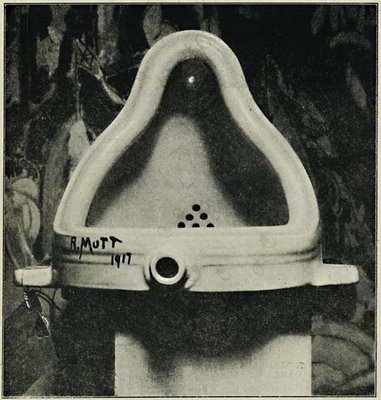


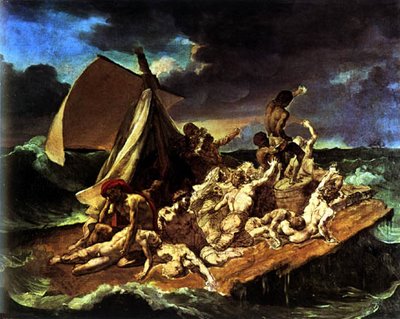




0 Comments:
Post a Comment
Links to this post:
Create a Link
<< Home